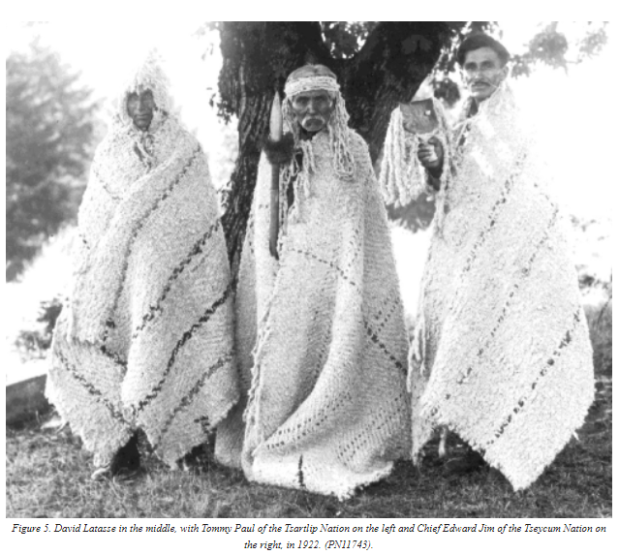1919: W̱SÁNEĆ Chief Edward Jim letter to Canadian government, partly in CW
University of Victoria doctoral student (I’m going to say Dr.) Gordon Lyall told me some background on a bit of Chinook Jargon he’d sent my way, regarding a place called “Styess” in the SENĆOŦEN language:

Chief Edward Jim of the Tseycum First Nation is on the right (image credit: Royal BC Museum)
“In 1919, a settler named Lieutenant Leonard Higgs reached out to the Department of Indian Affairs (DIA) to see if he could be granted use of a portion of the W̱SÁNEĆ [“Saanich” Salish] reserve no. 8 at Hay Point on Pender Island for farming purposes. He really wanted to pre-empt, but that was not possible given that it was federally-controlled property. The DIA supported this request because they considered the reserve, which was used as a fishing station, to be an “eye-sore.” In order to facilitate such an arrangement a Band Council Resolution signed by W̱SÁNEĆ chief and councillors would be required. The text [below] comes at the end of a letter written by Chief Edward Jim politely turning down Higgs. The timing of this is key, a few years prior, there was a Royal Commission, which Jim mentions in the letter, that reviewed and negotiated the size of Indian Reserves in British Columbia after years of acrimony between the province and Canada. During this commission, Bands were consulted and given a chance to speak about the quality and size of their reserves, often resulting in requests for additional land. This is what Jim reminds [Chief Inspector of Indian Agencies for BC, William] Ditchburn of, the W̱SÁNEĆ community wanted MORE land, they weren’t interested in selling or leasing the small reserves they already had.”
Now here is the Chinuk Wawa part of Chief Jim’s letter; it’s his closing thoughts:

“Therefore we again say to Mr Higgs (Muchuldun)
Kana sum Tloos Tilicum Kopa yaka.
kwánisəm ɬúsh tílixam kʰupa yaka.
always good friend to him.
‘[We’ll] always be good friends to him.’Helo sa-lix Tumtum, spoze Nainish saanich tilicum Tloose wawa.
hílu sáliks-təmtəm, spus nánich sénich-tílixam, ɬúsh wáwa.
not angry-heart, when see “Saanich”-people, good talk.
‘No mean thoughts, when [he] sees Saanich people he has a good word.’Tla ha we yea Tilicum“
ɬax̣áwya, tílixam.
goodbye, friend.
‘Goodbye, friend.’
Chief Jim’s spellings are a very interesting amalgam of those common in published Chinook Jargon dictionaries of his time and his own expressions of what things sounded like to him.
His CJ is fluent. Too bad it’s so terse! I would dearly love to have heard more of it.
Bonus fact:
Apparently Mr. Higgs was even known by a SENĆOŦEN name, written by Chief Jim as “Muchuldun“. I wonder if this could be a variant of a Settler’s name that’s in the SENĆOŦEN dictionary, phonologically /məčəl/. Maybe it’s got the lexical suffix /=tən/ ‘instrument, tool, etc.’ or the passive-voice suffix /-tən/ for some reason? I don’t find any more plausible explanation for “Muchuldun”, so I’d love to hear SENĆOŦEN experts weigh in.
The SENĆOŦEN place name written as “Styess” in Chief Jim’s letter is apparently also the commonly used name for all of Pender Island, especially North Pender.
It’s quite nice to find some of the earliest words of SENĆOŦEN written by native speakers!
